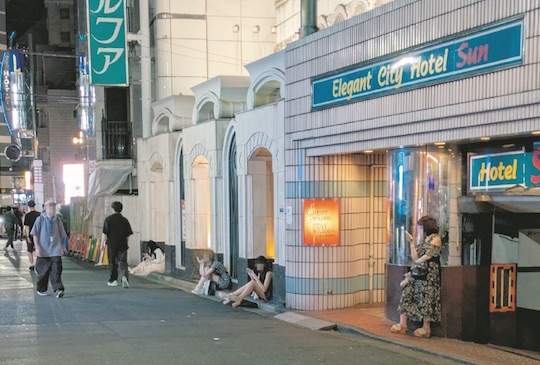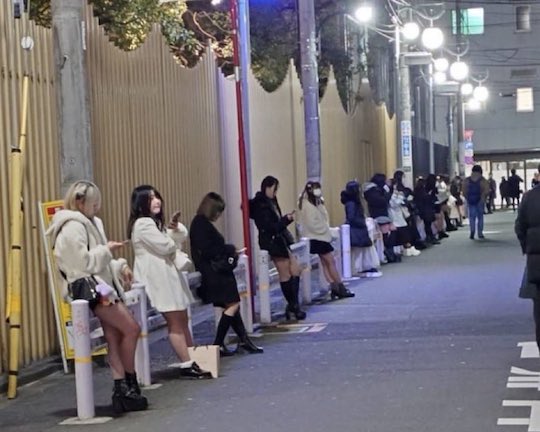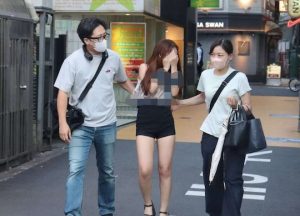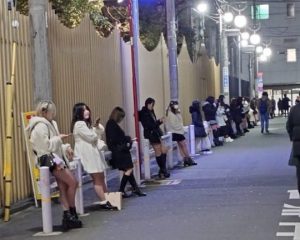Foreign men account for 70% of clients for some Kabukicho prostitutes
The post-COVID uptick in streetwalkers in the Okubo Park area of Kabukicho, Tokyo, has been a media obsession for some time in Japan, generating a moral panic over the young age of the women and also some embarrassment because it has coincided with the huge rise in tourist numbers in Japan.
In the age of social media, going to rubberneck the lines of prostitutes at Okubo Park has become an activity for tourists to do as well as contributed to the notion that Tokyo is already a destination for sex tourism like Bangkok. Of course, approaching women on the street does not come without risk and some women have been arrested for defrauding foreign men, who complained to police when they didn’t get the sex they expected.
Between January and June this year, 75 people were arrested on suspicion of violating the Anti-Prostitution Act by loitering and soliciting for customers, which is more than double the number arrested during the same period last year.
The young women loiter around the edge of the park or in an alley near hotels, sitting or standing at discreet intervals from one another, and pretending to look at their phones. They wait for men to approach them. A quiet negotiation then unfolds and if they come to an arrangement, they head off together to the nearby blocks of love hotels. Known as tachinbo in Japanese, all of this takes place in public and, increasingly, under the case of onlookers’ phone cameras, so it takes some guts on the part of both the client and sex worker. Most people are wearing masks.

The women take the risk of arrest because they can take away more cash than if working at a brothel or for a call girl service, and because they can control which clients they agree to have sex with.
One arrested woman claimed that as many as 70% of her clients were foreigners. While we should treat her assertion with caution and also keep in mind that it is just a single woman, the Tokyo Shimbun picked up the claim and highlighted it in a recent report, noting glumly that Tokyo has become a destination for sex tourists.
The woman in her twenties was arrested by the Tokyo Metropolitan Police Department’s Security Division and is believed to have earned more than ¥100 million over a two-year period. The woman’s partner at the time of the arrest was a Taiwanese man. He had come to Japan as a tourist and said, “I learned on a popular Taiwanese social media site that there were women available for sex in Okubo Park.”
The rise in visible prostitution in places like Okubo Park has been blamed on host clubs and concafes targeting vulnerable young women and letting them accrue large debts.
The most commonly stated motive for doing sex work, according to the Tokyo Shimbun, among those arrested was “payment to a host or similar.”
One arrested woman in her twenties mentioned in the article said she “started doing tachinbo to pay off her debts,” and had allegedly spent ¥48 million on hosts over three years.
A support group official pointed out, “Some girls don’t reveal their true motives because they fear it will cause trouble for their favorite host. From my experience, 80 to 90% of the motives are the host.”
Of course, it could also be that the true motive is something entirely. Unscrupulous hosts are an easy target for the authorities, media, and arrested prostitutes, but the real causes behind the prostitution increase (or at least, the rise in visible prostitution) are likely more complex.

It’s not just Tokyo. Osaka has also witnessed an increase in young streetwalkers, though it is much harder to ascertain if actual prostitution has risen. The police have responded with sweeps and arrests, and also crackdowns on concafes.
In order to break the negative cycle of women becoming addicted to hosts and being forced into prostitution, the government revised the Entertainment and Amusement Act, which came into effect in June. It now prohibits forcing women into prostitution in order to pay, and penalties have been significantly strengthened.















6 Comments
Most of the foreign men hookup with non Japanese prostitutes which seem in abundance there. There is a Brazilian who tapes his interaction with these foreign prostitutes. Some of them are ladyboys. The youtuber NOMADE JESUS is the channel
If the women would just be independent freelancers to make money, they wouldn’t be in debt to those hostess clubs…they could make enough on their own as prostitutes for themselves
Thought the biggest increase in foreign clients were Chinese, isn’t it time the authorities admit the real reason so many young women enter the night trade is its this generations “get rich quick scheme” while living a hedonistic / materialistic lifestyle – if Host bar guys were the reason, how come its not showing up in the arrest rates.
Not sure why foreign men looking for foreign prostitutes? It’s like traveling to Japan and avoiding Japanese food for foreign eateries
@Jason
There are probably a fair few non-Japanese at Okubo Park but it’s mostly Japanese. That’s why the media is stirring up such a moral panic. Until recently, our only experience of obvious streetwalkers in Tokyo were Chinese, in areas like Dogenzaka in Shibuya, Yaesu at Tokyo Station, or the north gate of Ikebukuro Station. It’s weird to see so many young Japanese engaged in sex work so publicly. Normally, they would choose the discretion of a fuzoku service. It speaks to the precarious post-COVID socioeconomic situation in Japan. There’s always been a huge sex industry in Japan, but it’s rarely been so overt.
Planning my next venture I will be selling food from a van parked next to Okubo Park. Will sell hot dogs and hoe cakes.